by Jim and Melanie
It was a little past 7 pm. Dinner was finished. The three of us decided to go to the waterfront park for the evening to enjoy the bay and watch people.
“I rode 65+ miles yesterday morning with the bicycle group. My legs are tired from that hard ride. I could use a slow ride to stretch and relax. You two go ahead to the park and find a bench in the usual place. I’ll follow up and meet you a few minutes later on my bicycle.”
We drove down the steep hill to the waterfront. I could see him farther back in the distance in the rear-view mirror going slowly down the rough streets. We reached the parking area and crossed the street to get onto the walkway. It was a beautiful evening. Many people and some other bikers were out. Cars were going along the street, some entering and leaving driveways to restaurants. One car leaving in front of us backed up a few feet to allow us to walk past. We waved our thanks.
We were perhaps 20 feet past that driveway when we heard a strange crashing noise behind us. A bicyclist was sprawled face down on the pavement where we had just walked. He was not moving. The car that allowed us to pass was still sitting there, waiting to see what he would do. Then the realization hit us. That was our son on the pavement!
We rushed back to him. He struggled to sit up. We carefully laid him on his back to avoid any more movements. He was un-responsive at first. I asked nearby people if he had been hit by a car. “No. It’s like he just fell over.” A woman next to us who works at the hospital called 911 and answered their questions. First responders were on the way.
A policeman stopped to help. He parked his car to shield the scene and asked our son a few questions. He answered them all wrong. He had no idea where he was, what happened, what day or month it was, etc. He was still in a fog.
The firetruck arrived with the first responders who quickly assessed his condition. An ambulance arrived. They checked vitals again, put a neck collar on him, placed him on a back board, and loaded him into the ambulance. “Which hospital do you want us to deliver him?” We had no idea. We were first-time visitors to the city. They headed downtown to the closest one. We knew where that was.
We wheeled his bicycle to our car and took the front wheel off so it would fit in the back seat. We headed for the emergency room to find our son. The last we saw of him he was joking with an EMT about something. That was a good sign. But, the vision of him on the backboard, still wearing his helmet and a neck collar, worried us. How bad was he hurt?
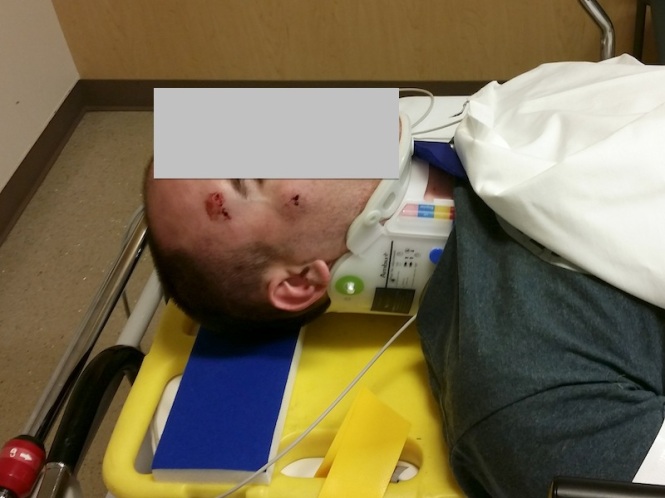
In the ER right after his helmet was removed.
The impact was mostly in three places. The one above his eye was what knocked him out. The helmet was broken by that impact. His cheekbone was knocked pretty hard. And, the front of his right shoulder was sore. The ER doctor ordered CT and x-rays of those areas and confirmed no breaks or internal bleeding. We were allowed to take him home by about 11 pm.
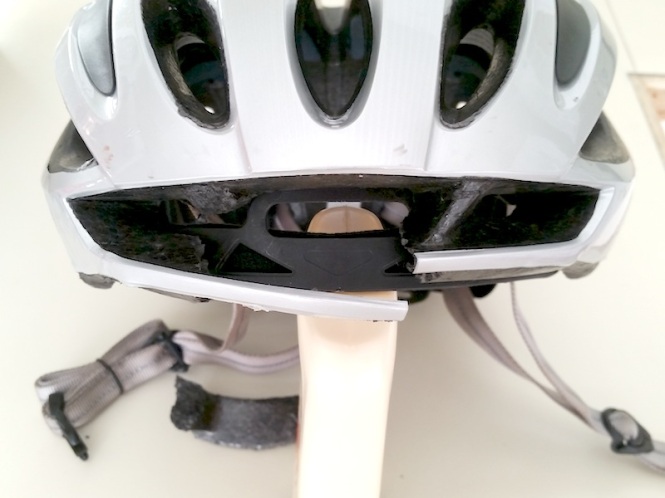
Front view. Impact was from the left. Notice the broken piece of foam.
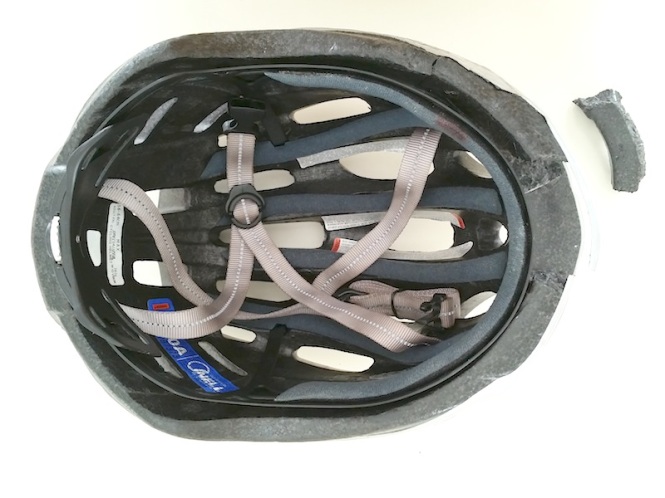
Front of helmet is at right. Impact was from top right.
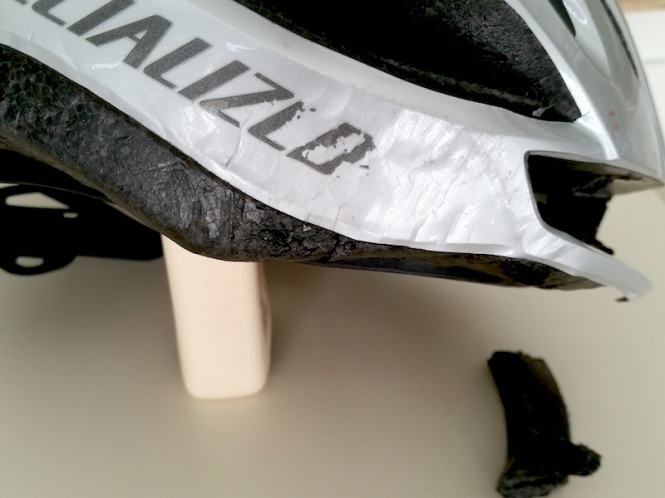
Point of impact was above his right eye.
The helmet performed as it was designed. The impact absorbed the kinetic energy by deforming and collapsing enough to break apart. This allowed his head and brain to slow down in the largest possible distance, maximum time, and with the least possible deceleration. A blow of that force could have been fatal without the protection of the helmet. The driver of the firetruck said about 3 times that it was a good thing he was wearing his helmet. They have seen much worse outcomes without helmets.
Our son was wearing training gear of a heart monitor and GPS tracker. He reports his ride statistics to a web site that charts his progress over the weeks. The GPS said he was going 12 mph, a very controlled and leisurely pace. Not a pace that you would expect to risk injury.
He is in great shape and rides regularly. He completed a 7 day 450 mile RAGBRAI ride across Iowa this summer with no falls or incidents. An accident can happen to anyone at any time.
Two days later, we visited the crash site to find out what caused his fall. He still didn’t remember details of the crash and wanted to piece together more of it in his mind. He stood over the spot where he landed on the driveway apron next to the road. He was riding from the back left toward the front right as he crossed the boundary from street to driveway. It didn’t look like there were any hazards.
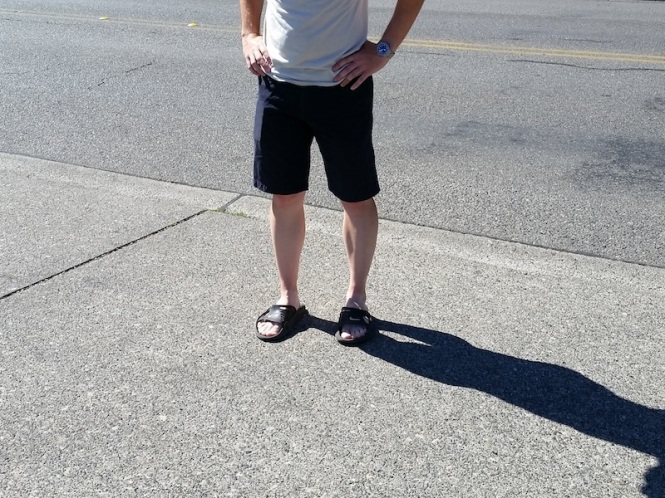
Seen from his earlier point of view just before leaving the street onto the driveway apron, there is a small 1.5″ tall edge of concrete. That edge caught his front wheel. The shallow angle of approach forced the front wheel left as his body continued forward and down to the pavement. He remembers aiming his attention and bicycle in the direction of the curved lip of walkway so he could avoid people and other hazards. That is the last thing he recalls. It was evening and shaded. He was wearing protective sunglasses that made the concrete edge less obvious. The concrete edge wasn’t a big obstacle. But, it was enough to bring him down.
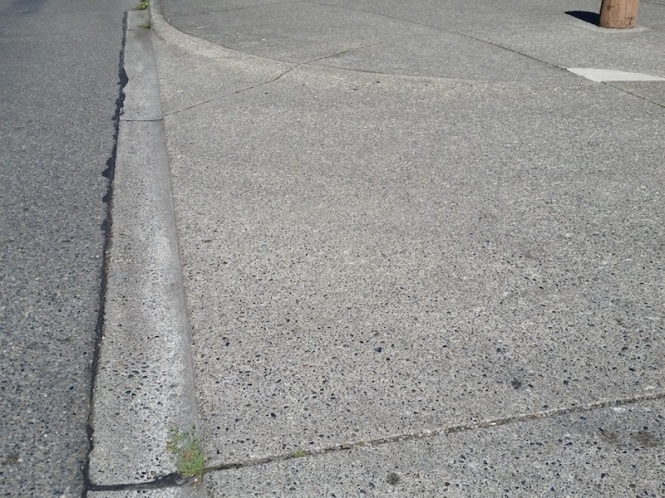
He was headed from lower left toward top center.
It has been almost a week since his accident. He feels almost normal except for very minor headaches, some bruising, and tender spots. We have been going through scenarios in our minds of how differently things could have turned out. That is normal after a thing like this to imagine those what-ifs.
Lesson learned is to be prepared for accidents by wearing the proper safety equipment.
Always Wear Your Helmet
Resources
A Buyer’s Guide to Bicycle Helmets
Some additional answers to questions about helmets
How to Fit a Bike Helmet video of 7 minutes
Video on fitting a bicycle helmet on kids

Good reconstruction, Jim, and good advice.
This is also a good anecdote about risk statistics, I submit. When I was a boy I spent a lot of time on a bicycle and I recall several significant spills, none of which resulted in a significant injury I’m glad to say. As a young man I thought it a nice idea to have a motorcycle or scooter but never had the time or opportunity. It’s just as well because, as your son’t accident illustrates, riding on two wheels is the height of transportation vulnerability. A car with its belts, structure and airbags is obviously way safer.
Naturally, it would be a dull life if one never took risks, but your message about precautions and proper gear is a great lesson!
I agree about the dull life with no risks. By making the right choices of gear and method, one can enjoy those ‘riskier’ adventures in relative safety.
Thank you for stopping by this morning and for your comments.
Very good advice to always wear a helmet. Make sure your son takes it easy for a while to make sure he does not have a concussion.
He does have a concussion, but seems to be recovering well. Thanks very much.
Best wishes; hope he recovers well.
He bought an indoor training device to hook to his bicycle so he can ride safely.
Just be safe.
There’s no need to be paranoid about what might happen in this world, but your son’s story is a good example of the difference preparation and precaution can make, and why they’re so important. I’m glad his injuries were relatively minor, and that his recovery is going well.
In my case, you can substitute “seat belt” for helmet, and the story’s the same in broad outline: the accident that could have been fatal, but wasn’t. I couldn’t prevent someone from rear-ending me on the freeway, and sending me off like a pool ball to a side pocket while I was going 65, but I survived thanks to that seat belt. I put it on every, single time I get in the car.
Every. Single. Time. Good. I do even if just crossing a parking lot. I’m glad it’s my habit.
We often say ‘watch out for the other guy’ as advice for being careful. Even that doesn’t assure safety. In your case, how would you watch out for that kind of thing?
Good thing you were buckled in and protected. Our cars do have excellent technology to help up survive.
Yikes … cheers to the helmet doing its job.
Jim, I’m so sorry for what happened. Sending you wishes for a speedy recovery. Thanks for showing the inner structure of that helmet, now I know how solidly built they are. Get well soon!
Thank you, Maria. He is going to be fine. Our hope with this post is to show how easily a serious accident can happen which has the potential to change a life.
Helmets are remarkably good technology. They are strong, but not too strong. They’re designed to deform just enough and break before your skull does.
I bet the technology is good, and your image helped me to see that!
This is one time when I’m sure you’d rather not have had to think about forces, impacts, trajectories, and the like. If we can switch from physics to drama, we’ll thankfully say “All’s well that ends well.”
Very true. For a couple of days, we were imagining several awful ways this could have turned out.
He is trained with an MS in mechanical engineering. It was interesting to watch him evaluate the scene a couple of days later. I think we had it pretty well figured out. Those are details I’d rather not dwell on.
Oh my gosh. I can only imagine the horror you felt seeing him there like that. Thank goodness he is conscious and feeling better so soon. Head injuries can be so terribly serious.
He continues to do well. We had a video chat this morning. I asked him about it. He said his shoulder is a little tender. Nothing else bothers him. The doctors on the base will do testing and evaluations this week to assess his health again.
Thanks for your note. Yes, we were so surprised. I did a double-take when I saw him there.